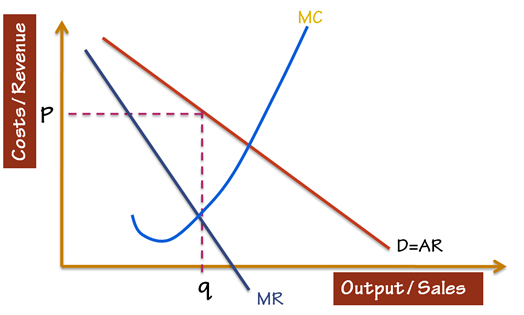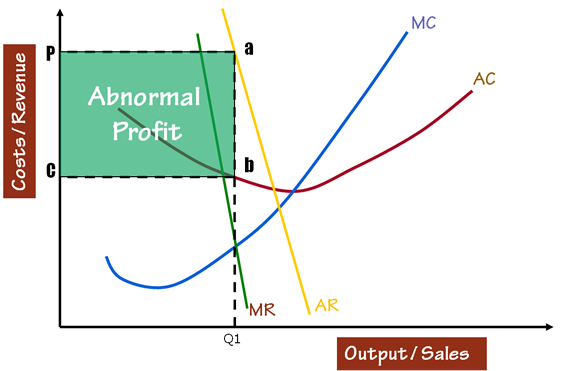What is a monopoly?
situation in which a single company or group owns all or nearly all of the market for a given type of product or service.
Monopoly – Assumptions
There is only one seller in the market.
Barriers to entry exists.
Due to the fact that monopolist is the industry, it is the price maker.
Monopolist is able to make abnormal profits.
Barriers to entry
Economies of scale
Economies of scale are the benefits of producing in large quantities. A firm producing in large quantities has lower average cost of production as compared to a firm which produces less quantities. http://www.dineshbakshi.com/igcse-gcse-economics/private-firm-as-producer-and-employer/revision-notes/1303-economies-of-scale
Natural Monopolies
An industry is classified as natural monopoly when a single large firm can produce for the entire market at a lower average total cost than two or more smaller firms.
This tends to be the case in industries where capital costs predominate, creating economies of scale that are large in relation to the size of the market, and hence high barriers to entry; examples include public utilities such as water services and electricity. It is very expensive to build transmission networks (water/gas pipelines, electricity and telephone lines); therefore, it is unlikely that a potential competitor would be willing to make the capital investment needed to even enter the monopolist's market.
In the diagram below, a monopolist will face a downward sloping demand curve D1 and the long run cost curve LRAC. The monopolist will produce between q1 and q in order to make abnormal profits.
Once another firm enters, and is able to take away the demand for the monopolist, the demand curve will shift to the left to D2, thus resulting in loss. As a result one of the firms will have to exit.

Branding
Certain firms may command monopoly power due to huge brand loyalty. The product is synonymous with the brand and it is very difficult for any other firm to exist. This is usually true for firms which innovate a new product line. E.g. Ipod. Ipod is a brand but is synonymous with mobile MP3 player.
Legal Barriers
This is a situation where a law prevents other firms from entering the market to sell a product. Many times a new firm may not able to enter the market due to the fact that an existing firm hold patents, copyrights to certain product. In many jurisdictions alcohol can only be sold by the government run corporation, creating a legal barrier to entry in this market. A patent gives the inventor of a product a monopoly in producing and selling that product for a limited amount of time. Pfizer, inventors of the drug Viagra, have a patent on the drug, thus Pfizer is the only company that can produce and sell Viagra until the patent runs out.
Anti-competitive behaviour
In many industries an existing monopolist may resort to anti-competitive behaviour in order to avoid other firms to enter the industry. These practices may be legal or illegal depending on the nature of the activity. A monopolist may use financial or knowledge power to avoid competition. It might resort to strong advertising campaign to avoid its customer base from breaking away. This is legal, however, there are many practices adopted by a monopolist which are illegal. These might include:
- Dumping, where a company sells a product in a competitive market at a loss. Though the company loses money for each sale, the company hopes to force other competitors out of the market, after which the company would be free to raise prices for a greater profit.
- Exclusive dealing, where a retailer or wholesaler is obliged by contract to only purchase from the contracted supplier.
- Price fixing, where companies collude to set prices, effectively dismantling the free market.
- Limit Pricing, where the price is set by a monopolist at a level intended to discourage entry into a market.
- Tying, where products that aren't naturally related must be purchased together.
- Resale price maintenance, where resellers are not allowed to set prices independently.
Revenue Curves
Demand Curve
A monopolist firm has a relatively large share of the market the firm and will face a downward sloping demand curve.
This table gives an example of a firm facing a downward sloping demand curve. The demand curve is given by the first two columns. We could plot the demand curve using these figures. Notice also that AR = P. When a firm faces a downward sloping demand curve, marginal revenue is the extra revenue gained by the firm from selling one more unit.
Total revenue equals Price X Quantity.
We can plot average revenue and marginal revenue on a graph.
A monopolist will try to maximise profit by producing at a level where MC=MR.

A monopolist will make abnormal profits in the short run and if the firm is able to sustain its monopoly status in the long run, it will continue to make abnormal profits.
The diagram below illustrates abnormal profits for a monopoly firm

Monopoly and efficiency
In a monopoly there is neither productive efficiency nor allocative efficiency.

As the diagram illustrates, productive efficiency is at Q2(MC=AC) and allocative efficiency is at Q3 (MC=AR), whereas the monopolist will produce at Q1 (profit maximisation level of output MC=MR). In order to earn abnormal profits, a monopolist is restricting the output in order to force up the prices.
Disadvantages of monopoly
- There are several reasons why monopolies may be thought to be against the public interest:
- It may charge higher price and produce a lower output than under perfect competition;
- In the long run there will still be higher price and lower output than under perfect competition as under perfect competition freedom of entry eliminates supernormal profit and therefore keeps longrun prices down; barriers to entry allow supernormal profits in the long run;
- The monopolist can still make large profits even if it is not using the most efficient technique of production;
- It may have less incentive to be efficient and innovate.
Advantages of monopoly
Despite these arguments, monopolies can have some advantages.
- It may be able to achieve substantial economies of scale owing to larger plant size, centralised administration and the avoidance of unnecessary duplication;
- The monopolist can use part of its supernormal profits for R & D and investment;
- The promise of abnormal profit, protected perhaps by patent may encourage the development of new monopoly industries producing new products;
- There are those who maintain that a monopolist has gained his status by being the most efficient in the industry. Indeed ‘Natural monopolies’ must also be mentioned here.





